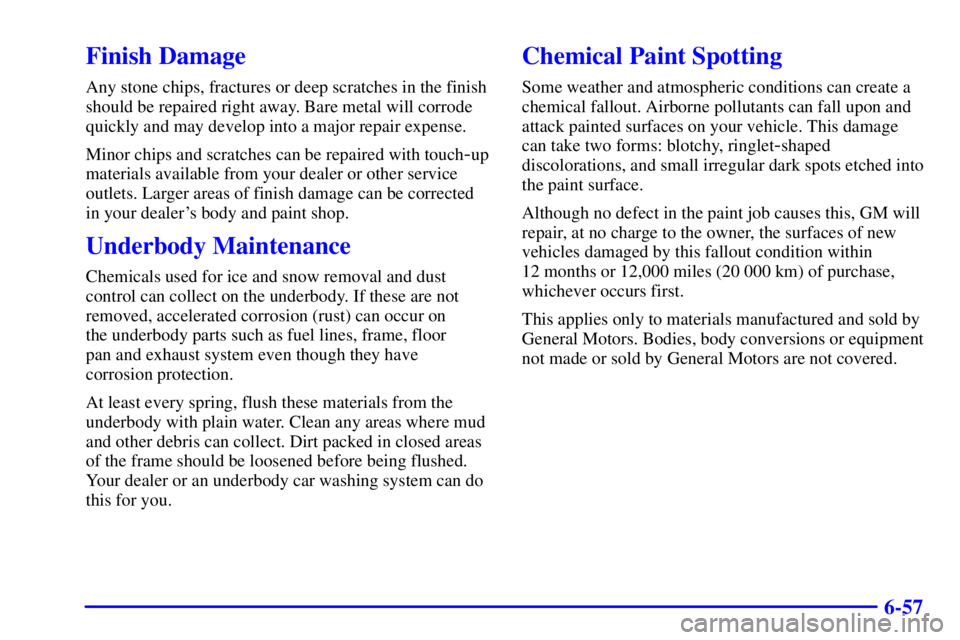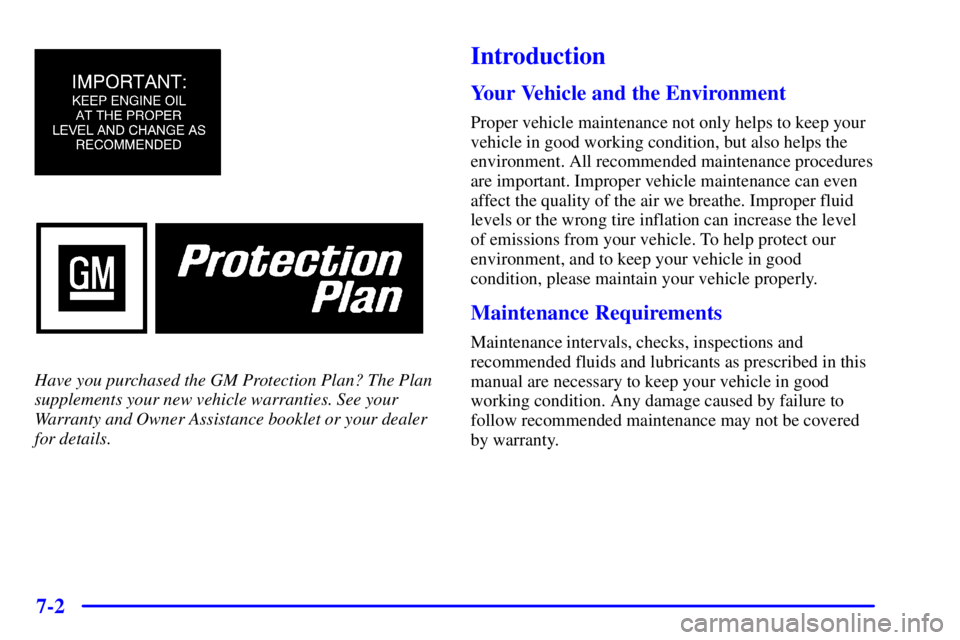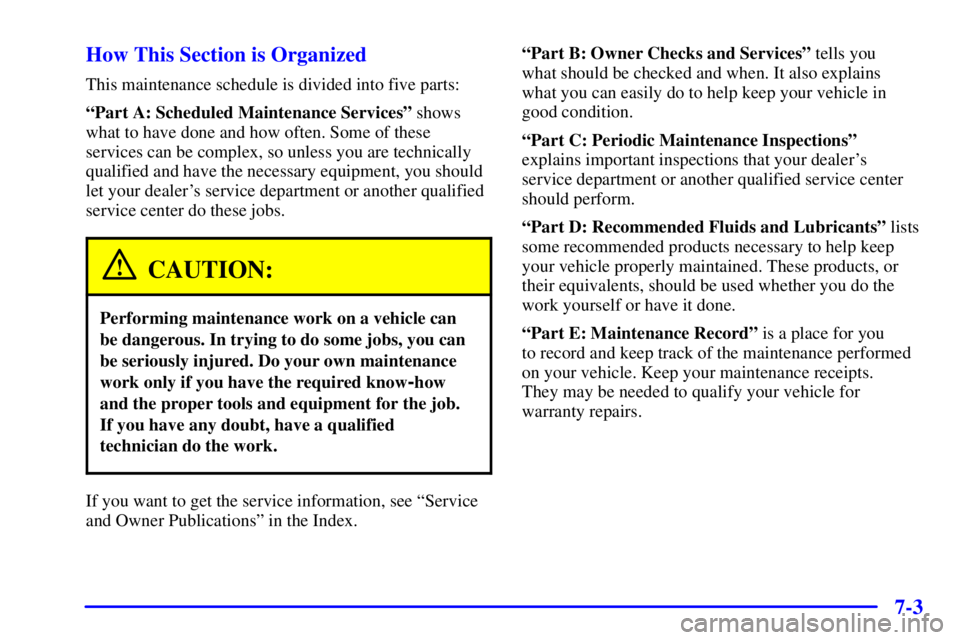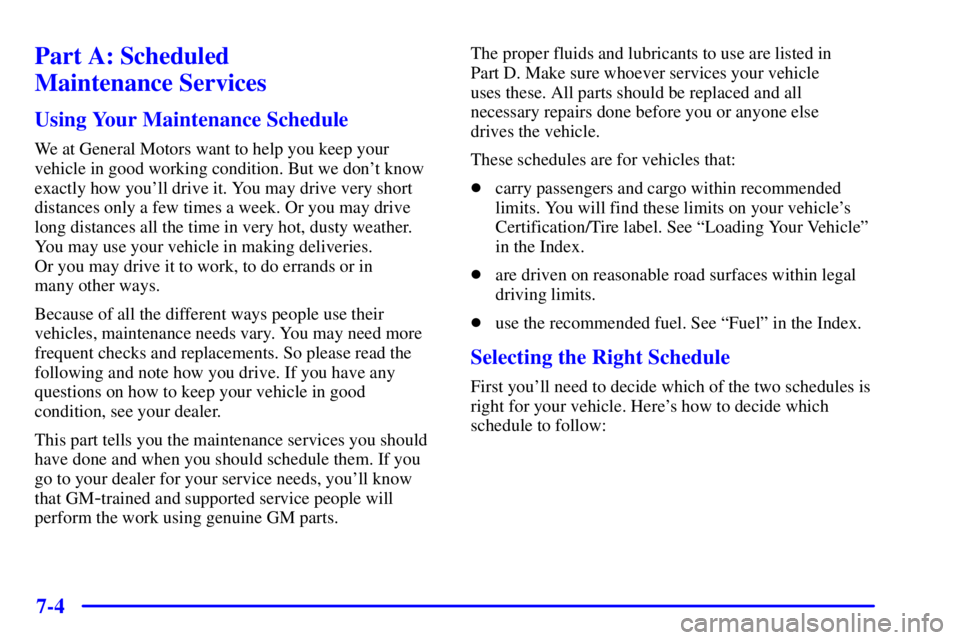Page 326 of 412

6-57
Finish Damage
Any stone chips, fractures or deep scratches in the finish
should be repaired right away. Bare metal will corrode
quickly and may develop into a major repair expense.
Minor chips and scratches can be repaired with touch
-up
materials available from your dealer or other service
outlets. Larger areas of finish damage can be corrected
in your dealer's body and paint shop.
Underbody Maintenance
Chemicals used for ice and snow removal and dust
control can collect on the underbody. If these are not
removed, accelerated corrosion (rust) can occur on
the underbody parts such as fuel lines, frame, floor
pan and exhaust system even though they have
corrosion protection.
At least every spring, flush these materials from the
underbody with plain water. Clean any areas where mud
and other debris can collect. Dirt packed in closed areas
of the frame should be loosened before being flushed.
Your dealer or an underbody car washing system can do
this for you.
Chemical Paint Spotting
Some weather and atmospheric conditions can create a
chemical fallout. Airborne pollutants can fall upon and
attack painted surfaces on your vehicle. This damage
can take two forms: blotchy, ringlet
-shaped
discolorations, and small irregular dark spots etched into
the paint surface.
Although no defect in the paint job causes this, GM will
repair, at no charge to the owner, the surfaces of new
vehicles damaged by this fallout condition within
12 months or 12,000 miles (20 000 km) of purchase,
whichever occurs first.
This applies only to materials manufactured and sold by
General Motors. Bodies, body conversions or equipment
not made or sold by General Motors are not covered.
Page 334 of 412
6-65
NAME CIRCUITS PROTECTED
ETC Electronic Throttle Control
RR BLOWER Rear Auxiliary Blower
Motor Relays
FUEL SOL Fuel Solenoid
ENG
-I Heated O2 Sensors, Mass Air
Flow Sensor, Evap Canister Purge
Valve, Crankshaft Position Sensor,
Secondary Air Injection Relay
(Diesel), Water in Fuel Sensor
(Diesel), Fuel Heater (Diesel),
Glowplug Relay (Diesel),
Wastegate Solenoid (Diesel)
ECM
-I Ignition Coil, Camshaft Position
Sensor, VCM, Fuel Injectors,
Coil Driver
IGN
-E Air Conditioning Clutch Relay
SPARE Spare Fuse
SPARE Spare Fuse
SPARE Spare FuseNAME CIRCUITS PROTECTED
A/C Air Conditioning Clutch Relay
HORN Horn Relay, Underhood Lamp(s)
ECM
-B Fuel Pump Relay, VCM, PCM,
Fuel Pump and Engine Oil
Pressure Switch
SPARE Spare Fuse
SPARE Spare Fuse
AUX A Upfitter Provisions
AUX B Upfitter Provisions
A/C RELAY Air Conditioning
HORN RELAY Horn
A.I.R. RELAY Air
FUEL PUMP
RELAYFuel Pump
STARTER
RELAYStarter
ABS EXPORT
RELAYABS Export
Page 339 of 412

6-70
Normal Maintenance Replacement Parts
Replacement Parts
Replacement part numbers listed in this section are based on the latest information available at the time of printing,
and are subject to change. If a part listed in this manual is not the same as the part used in your vehicle when it was
built, or if you have any questions, please contact your GM dealer.
These specifications are for information only. If you have any questions, see the service manual for the chassis or
refer to the body manufacturer's publications.
EngineªVORTECº 4300
V6ªVORTECº 5000
V8ªVORTECº 5700
V8ªVORTECº8100
V8
VIN W M R G
Oil Filter PF47 PF1218 PF1218 PF454
Air Cleaner Filter * A917C A917C A917C A917C
PCV Valve CV769C CV769C CV769C **
Spark Plugs
41
-932 41-932 41-932 TJ14R-P15
Fuel Filter GF481 GF481 GF481 GF481
Radiator Cap RC36 RC36 RC36 RC36
* Replace with ACDelco
� Air Filter, Part No. A917C and for severe dusty conditions,
use ACDelco� Air Filter, Part No. 1236C.
**8100 V8 has an internal PCV which does not require replacement.
Page 341 of 412

7-2
Have you purchased the GM Protection Plan? The Plan
supplements your new vehicle warranties. See your
Warranty and Owner Assistance booklet or your dealer
for details.
Introduction
Your Vehicle and the Environment
Proper vehicle maintenance not only helps to keep your
vehicle in good working condition, but also helps the
environment. All recommended maintenance procedures
are important. Improper vehicle maintenance can even
affect the quality of the air we breathe. Improper fluid
levels or the wrong tire inflation can increase the level
of emissions from your vehicle. To help protect our
environment, and to keep your vehicle in good
condition, please maintain your vehicle properly.
Maintenance Requirements
Maintenance intervals, checks, inspections and
recommended fluids and lubricants as prescribed in this
manual are necessary to keep your vehicle in good
working condition. Any damage caused by failure to
follow recommended maintenance may not be covered
by warranty.
Page 342 of 412

7-3 How This Section is Organized
This maintenance schedule is divided into five parts:
ªPart A: Scheduled Maintenance Servicesº shows
what to have done and how often. Some of these
services can be complex, so unless you are technically
qualified and have the necessary equipment, you should
let your dealer's service department or another qualified
service center do these jobs.
CAUTION:
Performing maintenance work on a vehicle can
be dangerous. In trying to do some jobs, you can
be seriously injured. Do your own maintenance
work only if you have the required know
-how
and the proper tools and equipment for the job.
If you have any doubt, have a qualified
technician do the work.
If you want to get the service information, see ªService
and Owner Publicationsº in the Index.ªPart B: Owner Checks and Servicesº tells you
what should be checked and when. It also explains
what you can easily do to help keep your vehicle in
good condition.
ªPart C: Periodic Maintenance Inspectionsº
explains important inspections that your dealer's
service department or another qualified service center
should perform.
ªPart D: Recommended Fluids and Lubricantsº lists
some recommended products necessary to help keep
your vehicle properly maintained. These products, or
their equivalents, should be used whether you do the
work yourself or have it done.
ªPart E: Maintenance Recordº is a place for you
to record and keep track of the maintenance performed
on your vehicle. Keep your maintenance receipts.
They may be needed to qualify your vehicle for
warranty repairs.
Page 343 of 412

7-4
Part A: Scheduled
Maintenance Services
Using Your Maintenance Schedule
We at General Motors want to help you keep your
vehicle in good working condition. But we don't know
exactly how you'll drive it. You may drive very short
distances only a few times a week. Or you may drive
long distances all the time in very hot, dusty weather.
You may use your vehicle in making deliveries.
Or you may drive it to work, to do errands or in
many other ways.
Because of all the different ways people use their
vehicles, maintenance needs vary. You may need more
frequent checks and replacements. So please read the
following and note how you drive. If you have any
questions on how to keep your vehicle in good
condition, see your dealer.
This part tells you the maintenance services you should
have done and when you should schedule them. If you
go to your dealer for your service needs, you'll know
that GM
-trained and supported service people will
perform the work using genuine GM parts.The proper fluids and lubricants to use are listed in
Part D. Make sure whoever services your vehicle
uses these. All parts should be replaced and all
necessary repairs done before you or anyone else
drives the vehicle.
These schedules are for vehicles that:
�carry passengers and cargo within recommended
limits. You will find these limits on your vehicle's
Certification/Tire label. See ªLoading Your Vehicleº
in the Index.
�are driven on reasonable road surfaces within legal
driving limits.
�use the recommended fuel. See ªFuelº in the Index.
Selecting the Right Schedule
First you'll need to decide which of the two schedules is
right for your vehicle. Here's how to decide which
schedule to follow:
Page 344 of 412

Scheduled Maintenance
7-5
Short Trip/City Definition
Follow the Short Trip/City Scheduled Maintenance if
any one of these conditions is true for your vehicle:
�Most trips are less than 5 to 10 miles (8 to 16 km).
This is particularly important when outside
temperatures are below freezing.
�Most trips include extensive idling (such as frequent
driving in stop
-and-go traffic).
�Most trips are through dusty areas.
�You frequently tow a trailer or use a carrier on top of
your vehicle.
�If the vehicle is used for delivery service, police, taxi
or other commercial application.
One of the reasons you should follow this schedule
if you operate your vehicle under any of these
conditions is that these conditions cause engine oil to
break down sooner.
Short Trip/City Intervals
Every 3,000 Miles (5 000 km): Engine Oil and
Filter Change (or 3 months, whichever occurs first).
Chassis Lubrication (or 3 months, whichever occurs
first). Drive Axle Service (or 3 months, whichever
occurs first).
Every 6,000 Miles (10 000 km): Tire Rotation.
Every 15,000 Miles (25 000 km): Diesel Engine Only:
Engine Air Cleaner Filter Inspection, if driving in
dusty conditions. Gasoline Engine Only: Noise
Shields Inspection (GVWR above 10,000 lbs. only).
Diesel Engine Only: Shields and Underhood
Insulation Inspection. Diesel Engine Only:
Thermostatically Controlled Engine Cooling Fan
Check (or every 12 months, whichever occurs first).
Diesel Engine Only: Air Intake System Inspection.
Front Wheel Bearing Repack (or at each brake
relining, whichever occurs first).
Page 345 of 412

Scheduled Maintenance
7-6
Short Trip/City Intervals
Every 24,000 Miles (40 000 km): Diesel Engine Only:
Fuel Cap Replacement, if driving in dusty conditions.
Every 30,000 Miles (50 000 km): Diesel Engine
Only: Engine Air Cleaner Filter Replacement.
Fuel Filter Replacement.
Every 50,000 Miles (83 000 km): Automatic
Transmission Service (vehicles over 8600 GVWR
or driven under severe conditions or equipped with
diesel engine).
Every 60,000 Miles (100 000 km): Engine Accessory
Drive Belt Inspection. If Equipped: Exhaust Gas
Recirculation System Inspection. Gasoline Engine
Only: Evaporative Control System Inspection.
Diesel Engine Only: Crankcase Depression Regulator
Valve (CDRV) System Check.
Short Trip/City Intervals
Every 100,000 Miles (166 000 km): Gasoline Engine
Only: Spark Plug Wire Inspection. Gasoline Engine
Only: Spark Plug Replacement. Gasoline Engine
Only: Automatic Transmission Service (normal
conditions). Gasoline Engine Only: Positive
Crankcase Ventilation (PCV) Valve Inspection.
Every 150,000 Miles (240 000 km): Cooling System
Service (or every 60 months, whichever occurs first).
These intervals only summarize maintenance services.
Be sure to follow the complete scheduled maintenance
on the following pages.